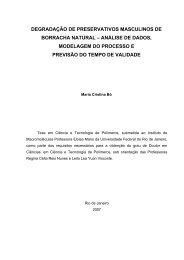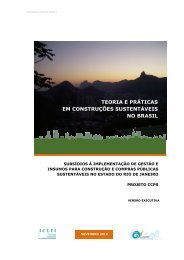A New Method for Protein Hydrolysis with Crystallized . Oxalic Acid
A New Method for Protein Hydrolysis with Crystallized . Oxalic Acid
A New Method for Protein Hydrolysis with Crystallized . Oxalic Acid
Create successful ePaper yourself
Turn your PDF publications into a flip-book with our unique Google optimized e-Paper software.
A <strong>New</strong> <strong>Method</strong> <strong>for</strong> <strong>Protein</strong> <strong>Hydrolysis</strong> <strong>with</strong> <strong>Crystallized</strong><br />
. <strong>Oxalic</strong> <strong>Acid</strong><br />
Rio de Janeiro<br />
1961
A <strong>New</strong> <strong>Method</strong> <strong>for</strong> <strong>Protein</strong> <strong>Hydrolysis</strong> <strong>with</strong><br />
<strong>Crystallized</strong> <strong>Oxalic</strong> <strong>Acid</strong><br />
The well known disadvantages of the conventional methods of protein<br />
hydrolysis prompted us to try "dry heating" of the protein <strong>with</strong> crystallized<br />
oxalic acid as hydrolyzing agent. This acid, already employed in the pyrohydrolysis<br />
of organic substances by FEIGL[1],was never tried be<strong>for</strong>e as a specific<br />
agent <strong>for</strong> breaking up the peptides bonds. Although LIEKENET AL.[2]observed<br />
a large carbonization and small cleavege of the protein by dry heating <strong>with</strong><br />
monochlor acetic acid or <strong>with</strong> o-chlor benzoic acid, oxalic acid proved to be<br />
an effective and useful hydrolyzing agent.<br />
The protein used in all experiments was a purified commercial grade<br />
of casein; the amino acids standards were obtained from Mann Research<br />
Lab., Inc.<br />
Troll and Cannan's reagents [3] were used <strong>for</strong> the ninhydrin reaction<br />
and the <strong>for</strong>maldehyde titration was per<strong>for</strong>med according to the Dunn and<br />
Loshakoff technique [4].<br />
The hydrolysis was followed by paper electrophoresis using a pH 5 O.lM<br />
pyridine-acetic acid buffer.<br />
Casein and the hydrolysing agent were mixed, in the desired proportion,<br />
ground and transferred to test tubes. Some of these tubes were sealed prior<br />
to hydrolysis. After a certain time of heating in oil bath, at 120°C, the tubes<br />
were cooled and the reaction products dissolved in water. It was observed<br />
that the mixture in the open tubes turned liquid after 15 minutes and remained<br />
liquid even after 6 hours of heating, after which it solidified. In the sealed<br />
tubes it remained liquid even after 24 hours of heating. After the reaction<br />
the sealed tubes had to be cooled in a dry ice-acetone mixture be<strong>for</strong>e being<br />
opened. This was necessary to avoid the violent explosions of these tubes.<br />
For the subsequent tests it became necessary to eliminate the acid,<br />
and the best result was obtained by utilyzing powdered CaC0 3 • This has<br />
the advantage of not increasing the volume of the liquid to any considerable<br />
extent, and when used in excess, remains insoluble. Other methods of eliminating<br />
the oxalic acid, such as ion-exchange resins were also tried giving, however,
poor results. The calcium oxalate (which contrary to BaSOo! adsorbs very<br />
little of the amino acids) was filtered off and washed a few times <strong>with</strong> hot water.<br />
The filtrates were combined and made up to a known volume; from this solution<br />
aliquots were taken <strong>for</strong> <strong>for</strong>maldehyde titration, ninhydrin reaction and paper<br />
electrophoresis.<br />
In order to have a better understanding of the hydrolitic process,<br />
other hydrolitic agents such as anhydrous oxalic acid and crystallized salts<br />
were used as shown in Table 1.<br />
<strong>Protein</strong> Time of<br />
HYDROLYSING AGENT hydrolysing hydrolysis Ninhydrin value<br />
agent ratio in hours<br />
<strong>Oxalic</strong> acid (2H20) ................ 1:1 6 0,735 (a)<br />
Same ............................. 1:2 6 1,570 (a)<br />
Same ............................ 1:5 6 2,180 (a)<br />
Same ............................. 1:10 6 2,600 (a)<br />
Same ............................ 1:20 6 2,660 (a)<br />
Same ............................ 1:50 6 2,800 (a)<br />
<strong>Oxalic</strong> acid (anhydrous) ........... 1:10 6 0,000 (a)<br />
Sodium sulphate (10H 2 0) .......... 1:10 24 0,040 (b)<br />
Sodium acetate (3H20) ............ 1:10 24 0,095 (b)<br />
The amino acids recovery (Table II), was measured by the ninhydrin<br />
reaction after 6 hours of hydrolysis <strong>with</strong> oxalic acid. In the particular case of<br />
tryptophane it was also determined spectrophotometric ally at 280 m J.L.<br />
AMINO ACIDS I Recovery<br />
(%)<br />
Arl;inine .... .. .... . ... . .... 60<br />
Serine ... ... . . . ....... ... . 65<br />
Cysteine ...... ... . . . . ... . . . . 76<br />
Threonine ...... .. . . ... .... . . . 78<br />
Tryptophan ........ .... . . ... 90<br />
Phenylalanine ....... .. . . . . . 100<br />
Tyrosine .... .. . .. . .... . ... 100
process,<br />
:ed salts<br />
As can be seen in the Tables I and II and Figures 1 and 2, the dry<br />
heating of a protein <strong>with</strong> crystallized oxalic acid causes the breaking of the<br />
peptides linkages <strong>with</strong> liberation of amino acids. This result was confirmed<br />
by paper electrophoresis and paper chromatography.<br />
The hydrolysis in sealed tubes is more complete and less destructive<br />
than m open tubes.<br />
i (a)<br />
I (a)<br />
(a)<br />
(a)<br />
(a)<br />
" '.<br />
2<br />
W<br />
"o<br />
cr<br />
•...<br />
i<br />
(a)<br />
(a)<br />
(h)<br />
(h)<br />
o OPEN TUBES SERlE<br />
" SEALED TUBES SERlE<br />
hydrin<br />
case of<br />
Fig. 1 -- Casein hydrolysis <strong>with</strong> crystallized oxalic acid. The hydrolysis was followed <strong>with</strong><br />
the Sorensen titration (4).<br />
Experiments showed (TABLE I) that the hydrolysing agent must<br />
be an acid and that the presence of water is necessary, as the anhydrous acid<br />
and the neutral salts had no hydrolytic effect. The best proportion of reagents<br />
<strong>for</strong> hydrolysis, were found to be 1 part of protein to 10 parts of oxalic acid,<br />
because it combined rapid hydrolysis <strong>with</strong> greater facility in the elimination<br />
of the acid. As can be seen in the TABLE II the present process, partially<br />
destroys some of the acids. However tryptophane, which is completely<br />
destroyed in the course of the conventional methods of acids hydrolysis, shows<br />
a 90% recovery after hydrolysis <strong>with</strong> oxalic acid. The speed of hydrolysis,<br />
the easiness of the elimination of the hydrolyzing agent and the preservation<br />
of some of the easily destroyed amino acids are the advantages of the present<br />
method of hydrolysis.
2,0<br />
~<br />
1=<br />
vt"<br />
~<br />
Ẓ.<br />
X<br />
..<br />
••j<br />
u<br />
dl<br />
a: 1,0<br />
0<br />
0 OPEN TUBES SERI'<br />
SEALED TUBES SERlE..<br />
'" eN '"'c,<br />
HY DROLYSIS<br />
dl<br />
2S<br />
IWST N.T[GNOLOCol.A<br />
IS-6-60-PGG<br />
Fig. 2 - Casein hydrolysis <strong>with</strong> 6N HCI and crystallized oxalic acid. The hydrolysis were<br />
followed <strong>with</strong> the ninhydrin reaction (3).<br />
A new process <strong>for</strong> the hydrolysis of proteins was developed, based on the dry heating,<br />
at 120°C, of the proteins, <strong>with</strong> cristallized oxalic acid. The influence of various factors, such<br />
as the duration of hydrolysis, temperature and protein-oxalic acid proportions were studied;<br />
parallel experiments in open and sealed test tubes were made, as well as conventional hydrolysis<br />
<strong>with</strong> acid solutions. All tests were followed up <strong>with</strong> Sorensen and ninhydrin reactions and<br />
paper electrophoresis.<br />
The stability of several amino acids in regard to this type of hydrolysis was investigated,<br />
a.~d the conclusions reached were in favour of the present method as it does not destroy the amino<br />
acids ordinarily decomposed in the course of acid hydrolysis and, also, allows an easy elimination<br />
of the hydrolysing agent (oxalic acid.)<br />
[1] FEIGL, F., (1958), Ang. Chernie, 70, 166.<br />
[2] DUNN, M. S. AND LOSHAKOFF, A., (1936), ]. BioI. Chern., 113, 359.<br />
[3] TROLL, W. AND CANNAN, K. K., (1953), ]. BioI. Chern., 200, 803.<br />
[4] LIEKEN, FAND AND TANDLER, R., (1959). Sci. Pharrn., 27, 82.







![ABM 2012 Torquímetros 20801[1].pdf - INT](https://img.yumpu.com/35773768/1/184x260/abm-2012-torquimetros-208011pdf-int.jpg?quality=85)





![Resumo biodiesel 2012 Raquel Rev cla[1].pdf - INT](https://img.yumpu.com/27723744/1/184x260/resumo-biodiesel-2012-raquel-rev-cla1pdf-int.jpg?quality=85)


